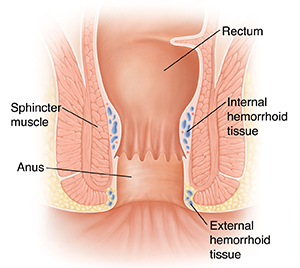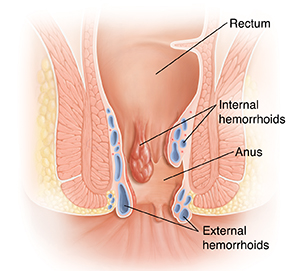Understanding Hemorrhoids
Hemorrhoids are blood vessels that swell slightly during bowel movements. They can be caused by things like:
Too much pressure on the anal canal can make these tissues stay enlarged. They may become inflamed and cause symptoms. This can happen both inside and just outside the anal canal.
Treatment may include:

Parts of the anal canal
The parts of the anal canal are:
-
Internal hemorrhoid tissue. This is in the upper part of the anal canal.
-
The rectum. This is the last few inches of the colon. This is where stool is stored before bowel movements.
-
Anal sphincters. These are ring-shaped muscles. They expand and contract to control the anal opening.
-
External hemorrhoid tissue. This lies under the anal skin.
-
The anus. This is the passage between the rectum and the outside of the body.
Normal hemorrhoid tissue
Hemorrhoids play a key role in helping your body get rid of waste. Food passes from the stomach through the intestines. The waste (stool) then travels through the colon to the rectum. It's stored in the rectum until it’s ready to be passed from the anus. During bowel movements, hemorrhoids swell with blood. They become slightly larger. This swelling helps protect and cushion the anal canal as stool passes from the body. Once the stool has passed, the tissues stop swelling. They go back to normal.
Problem hemorrhoids
Pressure due to straining or other factors can cause hemorrhoid tissues to stay swollen. When this happens to the hemorrhoid tissues in the anal canal, they’re called internal hemorrhoids. Swollen tissues around the anal opening are called external hemorrhoids. Depending on the location, your symptoms can differ.

-
Internal hemorrhoids. These often happen in clusters around the wall of the anal canal. They're often painless. But they may stick out of the anus (prolapse) due to straining or pressure from hard stool. After the bowel movement is over, they may then go back inside the body (reduce). Internal hemorrhoids often bleed. They can also discharge mucus.
-
External hemorrhoids. These are at the anal opening, just beneath the skin. These tissues rarely cause problems unless they form a blood clot (thrombose). When this happens, a hard, bluish lump may appear. A thrombosed hemorrhoid also causes sudden, severe pain. In time, the clot may go away on its own. This sometimes leaves a skin tag of tissue stretched by the clot.
Hemorrhoid symptoms
Hemorrhoid symptoms may include:
-
Pain or a burning feeling
-
Bleeding during bowel movements. The blood is often bright red. It coats the stool at the end of a bowel movement. Or it drips into the toilet.
-
Tissue sticking out from the anus
-
Feeling of blockage or fullness in the rectum during bowel movements
-
Itching around the anus
-
Mucus discharge from the anus
-
Fecal seeping out from the anus
Hemorrhoids can make it hard to clean the anal area after a bowel movement. This can cause increased irritation.
Causes of hemorrhoids
There’s no single cause of hemorrhoids. But in most cases, they're caused by too much pressure on the anal canal. This can be due to:
-
Ongoing (chronic) constipation
-
Straining during bowel movements
-
Chronic diarrhea
-
Sitting too long on the toilet
-
Strenuous exercise or heavy lifting
-
Pregnancy and childbirth
-
Aging
-
Being overweight or obese
Online Medical Reviewer:
Marianne Fraser MSN RN
Online Medical Reviewer:
Rajadurai Samnishanth
Online Medical Reviewer:
Rita Sather RN
Date Last Reviewed:
4/1/2024
© 2000-2024 The StayWell Company, LLC. All rights reserved. This information is not intended as a substitute for professional medical care. Always follow your healthcare professional's instructions.